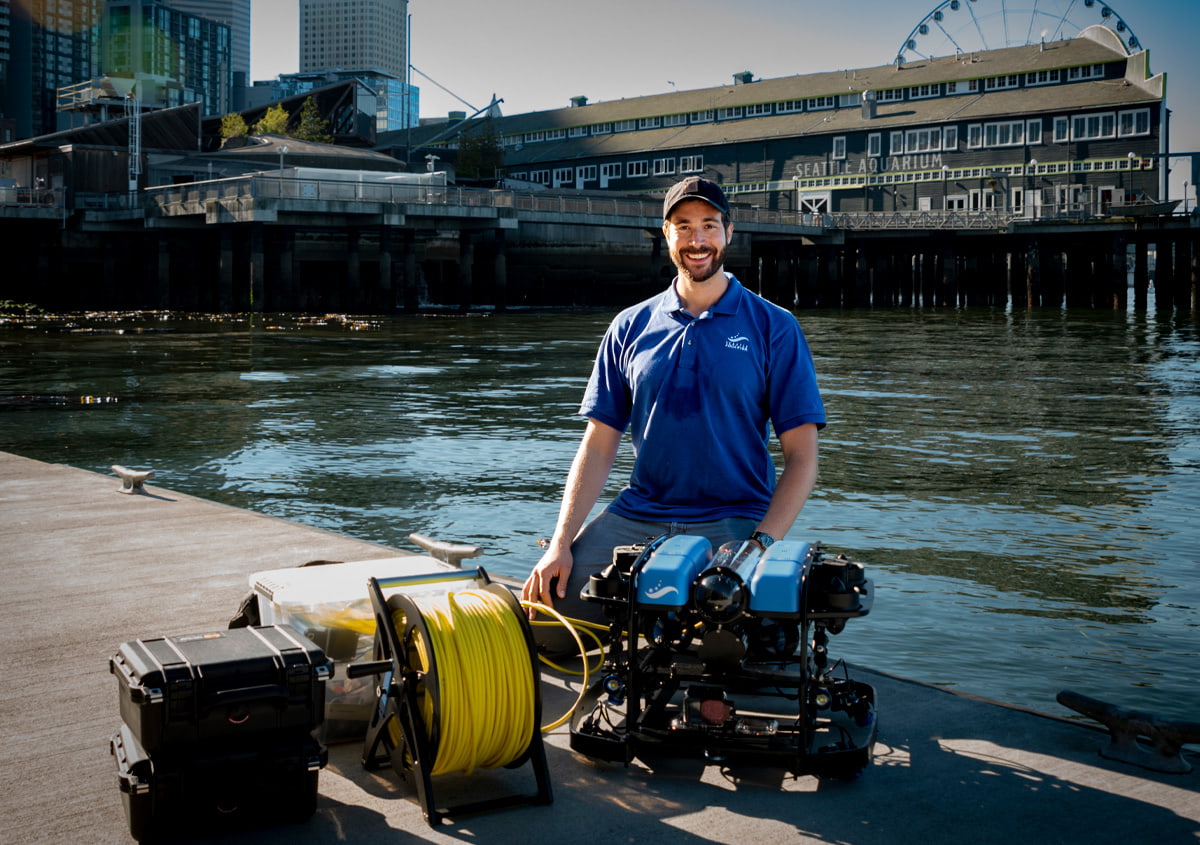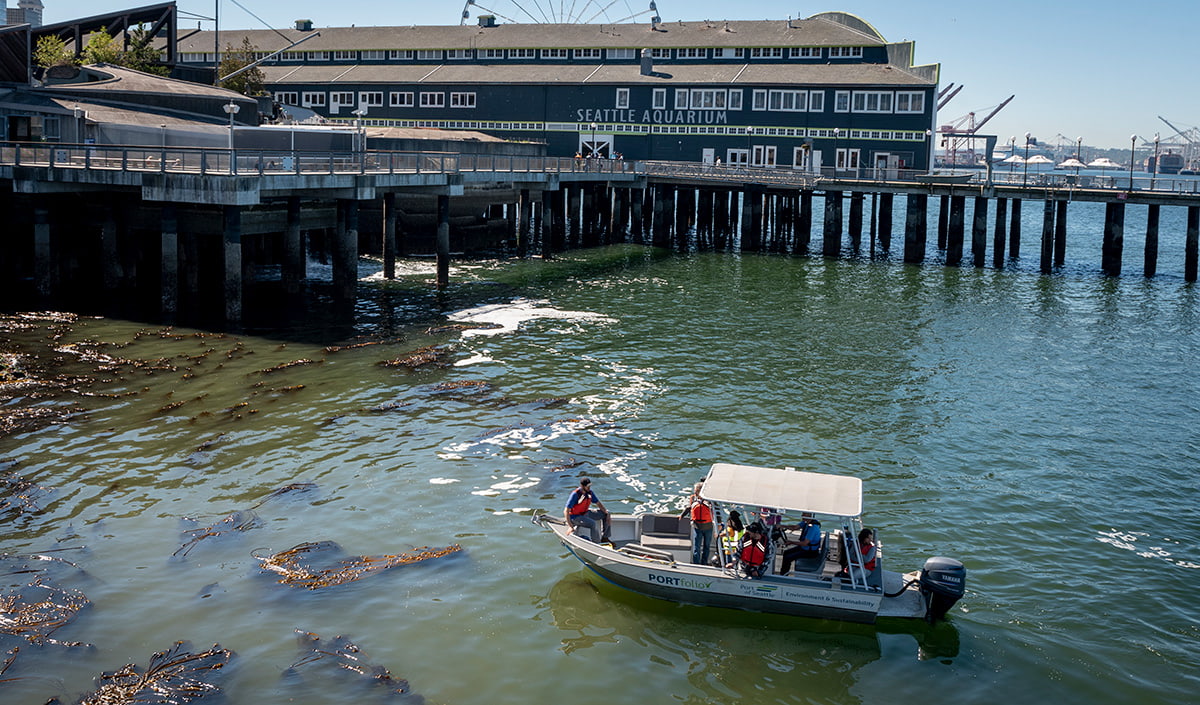
This story is part of our Nerdy Science Series—how we’re using research and technology in service of a healthy ocean.
On Saturday, April 22, 2023, Xbox and the Seattle Aquarium joined together for a live Earth Day celebration, including a demonstration of our remotely operated vehicle, Nereo!
Kelp forests are critical for ecosystem health. They provide food and habitat for marine species of all kinds, including endangered salmon and southern resident orcas. They also sequester carbon, mitigating the effects of ocean acidification. (Watch The Kelp Highway to learn more about the importance of kelp forests in the Salish Sea.)
Bull kelp forms the “trees” in these underwater forests. It attaches to hard surfaces on the seafloor and grows with incredible speed: up to 2 feet per day, reaching lengths of up to 100 feet in a single season.
But that’s if it’s growing. Once abundant throughout the Salish Sea, kelp forests have declined drastically over the past several decades, with a reported 60% overall loss of bull kelp in our local waters since 1980, and up to 95% in some areas.
What’s puzzling researchers, though, is that kelp forests continue to thrive in parts of the Salish Sea, including sections of Elliott Bay along Seattle’s urban waterfront (and directly below the Aquarium’s pier).

Partnering with the Port of Seattle to Learn More
Now the Seattle Aquarium is partnering with the Port of Seattle to study kelp forests in Elliott Bay using a remotely operated vehicle, or ROV, which we’ve fondly named ROV Nereo—short for Nereocystis luetkeana, the scientific name for bull kelp.
Research of this kind has typically been undertaken with scientific scuba divers doing surveys below the surface or via satellite imagery captured from far above. Both methods have their drawbacks: while divers can observe many species along the seafloor, they’re limited by the amount of gas they can carry on their backs and, ultimately, can’t cover much ground. Satellites, of course, can cover much larger areas—but aren’t able to capture kelp that hasn’t reached the water’s surface, or other species that live below it.
Enter the ROV. The compact ROV, that is. Historically, these machines have been large, bulky and expensive, and deployed from large vessels to explore deep water, which isn’t what’s needed to study kelp forests in relatively shallow depths.
ROV Nereo from Blue Robotics is small, relatively inexpensive, customizable and maneuverable—all critically important features when navigating long ropes of kelp and floating fronds. With cameras facing forward and downward, lights and sensor equipment, it can capture images of more species over a larger area than a scientific diver. ROV Nereo is easy to deploy and pilot, and equipped with sonar—so it will stay at a consistent altitude above seafloor—as well as GPS to track real-time positioning. All that, and it’s operated with an Xbox controller! You can learn more about the ROV and see video taken along the seafloor on the ROV development GitHub.

Kelp Conservation Meets Artificial Intelligence
Since the summer of 2022, led by the Aquarium’s Research Scientist Dr. Zachary Randell, we’ve been using ROV Nereo for benthic, or seafloor, surveys at eight sites in Elliott Bay. And here’s where things get even more futuristic: we’re harnessing the power of artificial intelligence (AI) to interpret the still images and video being captured by ROV Nereo’s cameras. Open-source AI algorithms can be “taught” to review images and identify what’s in them at a speed that simply wouldn’t be possible for a human being, or even a team of humans.
Using ROV Nereo and AI, we can learn about kelp abundance and distribution—in other words, the number of kelp plants and where they are—in Elliott Bay; see surfaces it’s growing, or not growing, on; and discover which animal species are present, competing with kelp, eating it or simply living within it.
With this information in hand, we’ll better understand why bull kelp is growing in some places but not others, and learn what conditions are needed for healthy, abundant kelp forests. That knowledge can help inform habitat restoration efforts underway throughout the region by our partners at the Puget Sound Restoration Fund and others. The ultimate goal? To reverse declines of local kelp forests, in Elliott Bay and throughout Washington waters, and develop solutions to rebuild the essential habitat that they provide.

Expanding Work
We were recently thrilled to learn that Dr. Randell and team have been awarded a grant by the Habitat Strategic Initiative Lead with funds originally from the Environmental Protection Agency to Washington Department of Fish and Wildlife and Washington Department of Natural Resources. This research, scheduled to begin later this year, will expand their work on bull kelp conservation and restoration. The team also received notice that they’d won a Sustainable Century Award in the category of “Environmental Innovation” from the Port of Seattle in April.
